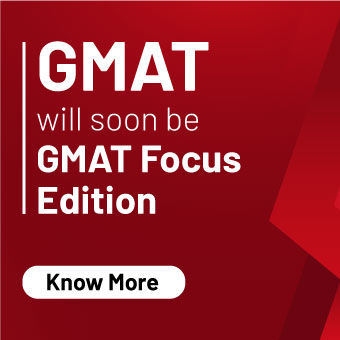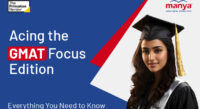
What does the GMAT Measure?
The Graduate Management Admission Test is a computer-adaptive test conducted at authorized test centers across the world. The test writers do not give a ‘syllabus’ that a student can work through to prepare for the test. However, understanding the GMAT exam syllabus is crucial as it helps in analyzing each section and its question types, giving insight into the content and skills tested on the GMAT. The GMAT is neither a test of academic excellence nor a test of intelligence or aptitude. However, analyzing each section and its question types will give an insight into the content and skills tested on the GMAT. If you’re considering study abroad, understanding the GMAT is often a key step in the application process.
The GMAT test is mainly divided into 3 sections and each section has fixed question types. The following chart will help you understand the sections.
Questions Per Section And Time Allotted To Each
| SECTION | QUESTION TYPES | NUMBER OF QUESTIONS | TIMING |
|---|---|---|---|
| Quantitative | Problem Solving
|
21 questions | 45 minutes |
| Verbal | Critical Reasoning Reading Comprehension |
23 questions | 45 minutes |
| Data Insights | Table Analysis
Graphics Interpretation Data Sufficiency |
20 question | 45 minutes |
Detailed GMAT Syllabus 2024
The GMAT Exam Pattern and Syllabus is quite important for students who will be taking the Graduate Management Admission Test and applicants who applied online for graduate management programs such as MBA and Masters in Finance. Understanding what is the syllabus of GMAT subjects can help in better preparation and targeted study.
Quantitative Reasoning Section
The quant section has 21 questions. The two question types tested in the quantitative section are:
- Problem Solving – as the name suggests, test-takers need to ‘solve’ these questions to get the answers. Approximately 17 to 18 problem solving questions come on the test.
GMAT Quantitative Syllabus:
Arithmetic
|
|
Algebra
|
|
Geometry
|
|
Verbal Reasoning Section
The verbal section has 23 questions. The two question types tested in the GMAT verbal syllabus are as follows:
Critical Reasoning: Critical reasoning questions measure reasoning skills to evaluate arguments. The major question types tested are:
- Assumption
- Strengthen/Weaken
- Evaluate
- Identify the Reasoning
- Flaw
- Inference
- Resolve /Explain
Reading Comprehension: Long and short passages followed by questions. Correct answers are supported by the information given in the passage. Questions can be based on the entire passage or specific parts of the passage.
Data Insights (DI) Section
The DI section measures the candidate’s ability to evaluate information presented in multiple formats and from multiple sources – such as text, charts, graphs, tables, etc. An on-screen calculator is provided only for this section of the test. One needs to get all the questions under an item right to get a point. The scoring for each item is all or nothing. The 5 types of Data insights questions are as under:
- Table Analysis – A table is provided and you are required to analyze it. The option of sorting is also available with these types of questions.
- Graphics Interpretation – Information is provided in the form of a graph. You are required to interpret the graph and answer the questions with statements given in a drop-down format.
- Multi-Source Reasoning – These questions can include either two or three tabs with the information presented as graphs, tables, or text. The questions asked may come in two flavors – Yes/No or statement style multiple choice question.
- Two-Part Analysis – For these questions, you pick two answers based on a similar situation. The first two columns are for selecting the answers for the two questions asked and the third column has the answer choices.
- Data Sufficiency – a unique question type where a test-taker needs to evaluate whether the given data is sufficient or not to answer a question – mostly there is no need to solve these questions entirely to choose the answer.
Check Your Score Now with a Free Practice Test
See where you stand with our practice tests. Find the right way to improve with our strategy sessions.
How To Apply For GMAT in 2024?
1. Set up an account at mba.com by clicking the ‘sign up’ button in the top right corner.
2. Candidates who want to take the GMAT exam should go to the website and fill out the GMAT 2024 registration form. The exam will be taken in an online format, thus registration will be required. Familiarize yourself with the GMAT course syllabus to understand the content and structure of the exam.
3. Candidates must fill out all of the relevant information on the portal. The application form will be rejected if any information is missing.
4. Students must provide their phone number and email address during registration. These two channels will be used to send all vital notices and alerts. So double check everything before submitting the form.
5. Candidates must also select test dates based on available slots.
6. Candidates have the option of selecting up to three different locations for the examination. Only choose a place that will be accessible on the exam date.
7. Add a passport sized photo and your digital signature to the form. On the online site, the size will be specified.
8. Submit the registration form once all of the details have been filled in. The information will be delivered to the mobile number and email address provided upon registration.
Exam Tips For GMAT Candidates
1. Make a strategy for covering the full GMAT course.
2. Don’t get hung up on a single question.
3. Keep track of your time and practice each portion.
4. Set aside as many hours as possible to study.
5. Select the appropriate study materials.
6. If necessary, enroll in coaching classes.
7. Be patient and put in extra practice time.
How To Prepare For The GMAT Critical Reasoning?
The GMAT critical reasoning questions are designed to be analytical and perplexing, with the use of “Jargon” encouraged and statements that appear to be in sync with one another rather than being useful to the learner. A candidate should spend less time reading and more time figuring out how to interpret controversial theories to locate evidentiary cues that will help them answer the issue.
You must decipher the meaning of the question. This will assist you in comprehending the information offered by the supposed data.
Identify the sentence’s dominant and weak components, then exercise the information gathering strategy with regard to the question’s contextual meaning.
Don’t simply read, comprehend, summaries, and build a developed context with connected comments. It’s all about taking risks and successfully putting your ability to extract the correct meaning from complex written information to the test. For a comprehensive understanding of the types of questions and strategies, refer to the GMAT syllabus PDF.
How To Prepare For The GMAT DI Section?
- Familiarize yourself with set-based reasoning issues, which are usually about maxima and minima values.
- Practice networking and logical connectives questions.
- Enhance the concepts of Vedic Maths to their full potential. Shear calculations make up the majority of Integrated Reasoning.
- Do not waste your time rushing from one set to the next. Pick an easy set to start with and solve it using a concept test. As you regain familiarity, progress up to more challenging questions to test your understanding.
- Read all of the possible answers carefully and use the “process of elimination approach” to ensure that your solution is correct from beginning to conclusion.
- Develop your analytical skills to identify differences among the sub questions.
- Familiarize yourself with the GMAT maths syllabus to ensure you cover all necessary topics.




















